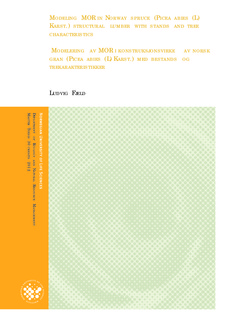| dc.contributor.author | Fjeld, Ludvig | |
| dc.date.accessioned | 2012-09-07T11:08:06Z | |
| dc.date.available | 2012-09-07T11:08:06Z | |
| dc.date.copyright | 2012 | |
| dc.date.issued | 2012-09-07 | |
| dc.identifier.uri | http://hdl.handle.net/11250/186792 | |
| dc.description.abstract | Correct allocation of the raw materials is important to cover the requirements of producers and
customers. To achieve this it is crucial to get a precise prediction of the wood properties early in the
conversion chain. The modulus of rupture (MOR) is of great importance when using lumber in load
bearing structures. An exact determination of the strength properties depends on the accuracy of the
measurement systems and the access to significant information related to MOR. The analysis and
model development were based on a total of 410 boards of Norway spruce (Picea abies (L.) Karst.),
sampled from three different sites in the southern part of Norway. The nominal height and width of
the planks tested were 100-200 mm and 50 mm, respectively. The two most common grading
systems used in Norway, visual grading after INSTA 142 and grading by resonance vibrations
performed with Dynagrade, were evaluated. Both grading systems reduced the MOR residual
variance significantly, but they undervalued MOR and the resonance vibrations were somewhat less
than the visual. Additionally, stand and tree characteristics were used. Models with IP values and
tree and stand variables, managed to reduce the residual variance more (R2 = 0.70) than modulus of
elasticity (MOE) measured in the laboratory. The MOE was found to be the best single variable in the
reduction of residual variance. The results showed that it might be useful to include stand and tree
characteristics in models used to strength grade Norway spruce sawn wood. Riktig fordeling av råstoff er viktig for å dekke behovene til kunder og produsenter. Det vil være
kritisk å kunne påvise presise egenskaper til tremateriale tidlig i produksjonskjeden. Bøyefastheten
(MOR) har stor betydning for bruk av tre i bærende konstruksjoner. Nøyaktigheten til måleutstyret
og tilgang til informasjon relatert til MOR er viktig for å kunne påvise disse egenskapene best mulig.
Analysene og modellutviklingen er basert på totalt 410 planker av norsk gran (Picea abies (L.) Karst),
hentet fra tre bestand i sør Norge. Materialene som ble testet hadde nominell høyde mellom 100 og
200 mm og nominell bredde på 50 mm. To av de mest brukte sorteringssystemene i Norge, visuell
styrkesortering etter INSTA 142 og sortering med bruk av resonans vibrasjoner ble evaluert. Begge
systemene reduserte signifikant residualvariansen til MOR, men de undervurderte MOR. Resonans
vibrasjoner dog noe mindre enn de visuelt bedømte. IP-verdier (Indikatorverdier fra Dynagrade) ga
størst bidrag til å redusere residualvariansen til MOR. Sammenhengen mellom plankkvalitet og MOR
var best for de gode bonitetene (R2 = 0.44). Bestands- og tre karakteristikker ble også brukt som
forklaringsvariabler. Modeller med IP verdier og bestands- og trevariable reduserte mer av
residualvariansen (R2 = 0.70) enn laboratoriemålt elastisitetsmodul (MOE). MOE var allikevel den
enkeltvariabelen som reduserte residualvariansen mest. Resultatene viste det kan være nyttig å
inkludere bestands- og trekarakteristikker i modeller som styrkesorterer planker av norsk gran. | no_NO |
| dc.language.iso | eng | no_NO |
| dc.publisher | Norwegian University of Life Sciences, Ås | |
| dc.title | Modeling MOR in Norway spruce (Picea abies (L) Karst.) structural lumber with stands and tree characteristics | no_NO |
| dc.title.alternative | Modelering av MOR i konstruksjonsvirke av norsk gran (Picea abies (L) Karst.) med bestands og trekarakteristikker | no_NO |
| dc.type | Master thesis | no_NO |
| dc.subject.nsi | VDP::Agriculture and fishery disciplines: 900::Agriculture disciplines: 910::Forestry: 915 | no_NO |
| dc.subject.nsi | VDP::Technology: 500::Materials science and engineering: 520 | no_NO |
| dc.source.pagenumber | 30 | no_NO |
